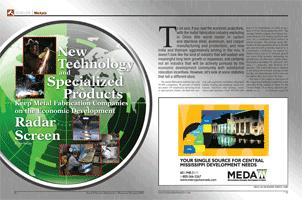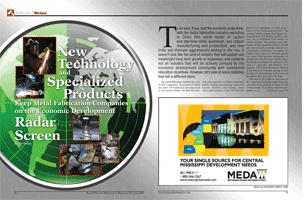
 To be sure, if you read the economic projections, with the metal fabrication industry exploding in China (the world leader in carbon and stainless steel, aluminum, and copper manufacturing and production), and now India and Vietnam aggressively joining in the mix, it doesn’t look like the kind of industry that will sustain any meaningful long term growth or expansion, and certainly not an industry that will be actively pursued by the economic development community with substantial relocation incentives. However, let’s look at some statistics that tell a different story.
To be sure, if you read the economic projections, with the metal fabrication industry exploding in China (the world leader in carbon and stainless steel, aluminum, and copper manufacturing and production), and now India and Vietnam aggressively joining in the mix, it doesn’t look like the kind of industry that will sustain any meaningful long term growth or expansion, and certainly not an industry that will be actively pursued by the economic development community with substantial relocation incentives. However, let’s look at some statistics that tell a different story.
The metal fabrication industry has over 50,000 companies, 58 percent of which are under 100 employees servicing local or specialized clients, divided into several sub-segments including structural metals, forging and stamping, metal containers, hardware and springs, metal valves and fasteners. Over 593,000 jobs and a U.S. Department of Labor projection of 53,000 more needed by 2014. The average metals company has annual revenues between $10 million and $100 million, for a combined $200 billion in annual revenue. The average metal fabrication worker generates about $150,000 per year in total economic benefit to a community. Combined, the metals industries have seen a 9.5 percent growth rate since 2004, actually surpassing the growth rates of other more visible industries such as aerospace (8.1 percent), utilities (7.1 percent), and retailers (6.5 percent), The metal fabrication industry is not sitting on its hands waiting for the last die cast manufacturer left to turn out the lights when they leave for Asia.
The truth of the matter is that most of the Asian metal industry expansion is not currently being loaded on boats for the United States. It is being exported primarily to (1) other Asian countries, and (2) Europe and other locations where the exchange rate is more favorable. To be sure, outsourcing, and that subsequent portion of the Asian manufacturing that has been directed to the United States, especially during the tumultuous outsourcing of the 80’s and 90’s by the major metals industry companies, did cause a substantial downturn in the industry. Nearly 50 percent of all metal industry manufacturing jobs were lost during that period. Even though these were primarily low wage, repetitive jobs, it still required that the metals industry look at what was needed to be done to the remaining companies to keep them competitive on a global basis. More efficient operations, industry specific targeting, and just in time logistics all have been contributing elements to the rise of the die cast and metal fabrication industry.
For example, the move in the auto industry to more aluminum die casting (two-thirds of all aluminum die casting produced in the Unites States are automotive related) and the growth in the number of transplant automotive assembly plants have gone hand in hand. Other industries that have had similar growth relationships with the metal fabrication industry include aviation and aerospace, defense industries, industrial equipment, industrial pipe and pipeline manufacturing, and logistics equipment manufacturing (truck trailers, railroad cars and maritime barges). The result is an industry that is on a new, but very different, path for growth. The Annual Manufacturers Survey conducted December 2006 showed that American manufacturing capacity was at better than 83 percent. Since downtime and retooling makes maximum manufacturing capacity plane out somewhere near the 87 percent level, many companies are now, or soon will be, looking at expansion or relocation.
For a metals company expanding or relocating, there are very specific indicators that should be considered in the site selection process; both in the location search itself, and the actual incentive negotiations. We will look at the case study of The Smorgon Steel Group, a fabricator of light weight steel beams for commercial and residential construction. Location Management Services (LMS) worked with Smorgon to establish their new manufacturing facility in Troutville, Virginia (a $25 million investment, creating 55 new jobs).
As we said earlier, the industry has dramatically changed in the last 20 years. New technologies have eliminated much of the “smoke stack” image associated with the industry. Specialization of metal products produced by these companies has made the need to be in a client / supplier location a requirement, nota convenience.
The need for a skilled workforce is mandatory. Logistics is a key element. Energy is the second largest cost increase behind employees in the industry. In some states, energy costs for manufacturing have gone up as much as 75 percent in the last three years. Local and state regulatory and permitting issues can kill a project. The need for third party confidentiality and compliance in the site selection process, and subsequent relocation assistance packages, is crucial.
Let’s look at each issue separately and how Smorgon Steel and LMS worked to address these issues in making their location decision.
When the decision to relocate or expand a facility is made, the two most important elements in securing the best site, and then securing a beneficial incentive package to offset construction and training costs, is confidentiality and compliance. The need for confidentiality eliminates premature disclosure of company plans that may negatively impact not only a company’s ability to secure the best incentive package, but also can affect the ongoing company operations by creating uncertainty among existing employees.
The issue of compliance with local and state programs is becoming a much larger issue than in prior years. The January 2007 issue of CFO Magazine dedicated a feature article on policies being implemented in many states that are actively targeting nullifying previously granted incentives through compliance “loopholes.” Only 13 percent of Fortune 500 CFO’s interviewed in a recent University of Georgia survey believed their company could meet the increased compliance requirements.
When the decision is made to look for a location, secure a company dedicated to the location and incentive process. If you had appendicitis, you wouldn’t try to do the surgery yourself first before you brought in a doctor. You know the metals business, they know site selection.
Energy is an operational problem that will not get better in the foreseeable future. Both rates for electricity and natural gas, critical to the metals manufacturing process, continue to rise at record levels. Any relocation should conduct energy negotiations wherever possible as a mandatory part of the process. Reverse auctions and negotiated rates in deregulated states can result in up to a 30 percent reduction in your energy costs. Currently there are 14 states that have deregulated electricity, and 35 that have deregulated natural gas. The key to energy cost reduction is to make sure it is done during the negotiated stage of location selection.
Demand in the metals industry is driven by the needs of other industrial companies, and is therefore linked to their economic growth. It is because of this specialized nature of the metal and die cast products needed to service other industries that makes site selection for the metal fabrication companies so critical. As we see a shift in the location of primary manufacturing industries to service the population shifts of the nation, we are also going to see more expansion and relocation in the metal fabrication industry. Bottom line, if your company supports a specific industrial base, such as automotive manufacturing or aerospace, production logistics in that industry will dictate the general target area of your relocation or expansion.
Smorgon Steel has substantial contracts in the Southeast and needed to commence manufacturing operations in this market area as quickly as possible to reduce the need for costly logistics from overseas operations. This required an existing facility. Smorgon and LMS, working with numerous community economic development organizations, found several acceptable existing facilities in the geographic zone that met the requirements.
The finalist communities were then reviewed for the relocation packages that they could provide to make the transition as seamless as possible for Smorgon. A 124,000-square-foot former manufacturing facility in Troutville was high on the “A” list of available facilities.
To assist Smorgon in converting the facility from its prior function to metal fabrication, the community provided $650,000 in grants from the Virginia Governor’s Opportunity Fund and county matching grants. In addition, an $800,000 sales and use tax exemption was granted on equipment purchases for the new facility. Once the facility was approved, LMS worked with the local officials and secured waivers on permitting fees, and assisted on state and local compliance issues and environmental compliance.
Metal fabrication, while still labor intensive, is more and more a skilled industry. Training of the workforce is normally done in one of four ways: four year formal apprenticeship, vocational schooling, community college programs in conjunction with industry, company sponsored in-house on the job training.
To provide Smorgon with the skilled labor force required, a grant of $120,000 from the state Workforce Services Training Grant Program was secured, and the community provided recruitment and training site space for Smorgon until the facility conversion was complete.
Logistics, of course, is a key in any relocation, and in many cases, the primary cause of relocation for some companies. This is not just the case of the metal fabrication industry; it is a factor in the location decision of every hard product and manufacturing industry today. However, because of their unique position of dependency on primary user industries supply structures, logistics becomes a priority issue in site selection of the metals industry. To provide Smorgon with the required logistic support, the Virginia Department of Rail and Public Transportation provided $600,000 in transportation infrastructure for the project to address rail access for Smorgon Steel.
The bottom line on site selection in the metal fabrication industry is to remember, incentives alone should never dictate the final decision on location. However, if all other criteria are equal, an aggressive relocation assistance package will make a good site into a great site.

